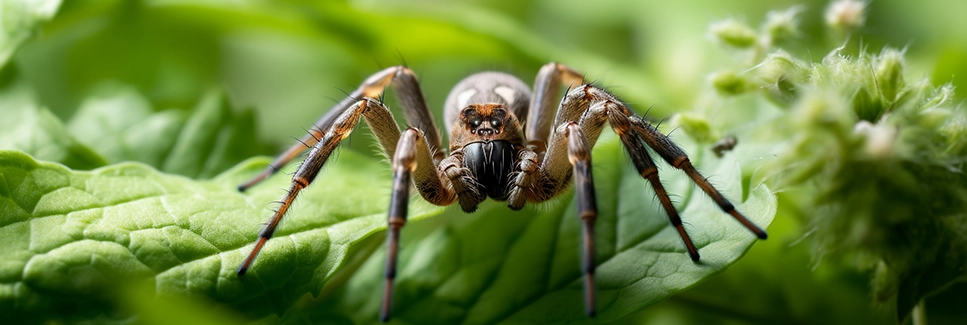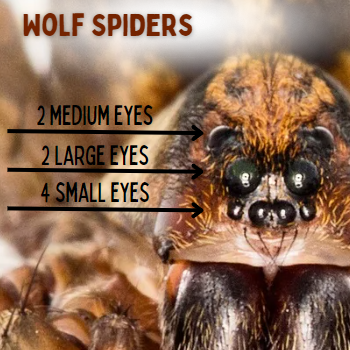
Wolf Spider - Florida Friend or Foe?
“Wolf spider” might sound intimidating, but these native arachnids commonly found in Florida, are an essential part of the ecosystem.
They are well-adapted to the state’s diverse habitats, ranging from gardens and wooded areas to coastal regions and urban environments and yes, it’s possible to find them inside your home!
In this blog, we’ll cover the ways to identify wolf spiders, most common wolf spiders in Florida, how to identify them, where you’ll typically see them, what attracts them and more.

How to Identify Wolf Spiders
There are over 2000 different types of wolf spiders found all around the world (family Lycosidae), on every continent except Antartica.
Lucky for those of us that aren’t fans of spiders, there are only a few types of wolf spiders in Florida!
However, no matter which type of wolf spider, they all have fairly common and easily identifiable characteristics.


Wolf Spiders have a distinctive eye arrangement
All wolf spiders can be identified by their unique eye arrangement of 4 small eyes on the bottom, 2 large eyes in the middle, and 2 medium eyes on top. This specific eye arrangement is a hallmark feature of the wolf spider family (Lycosidae).
Their eight eyes provide them with excellent vision, particularly at night, which aids them in their active hunting strategy. The larger eyes in the middle row are likely their primary eyes for seeing in low-light conditions.
More ways to identify most any Wolf Spider Florida has creeping around
- They have hairy bodies and long, spiny legs and are most often a medium brown color
- Size and Shape: They are generally a little larger than other common spiders, with their full length (bodies plus legs) ranging from 1.5 inches to 4 inches!
- Coloration: Their coloration typically varies from brown to gray, often with darker markings or stripes on their backs.
- Behavior: Unlike many other spiders, wolf spiders do not spin webs to catch prey. Instead, they are active hunters, often seen scurrying on the ground in search of food. They are considered ground-dwellers, and are not typically observed climbing high or upside down.
Most Common Type of Wolf Spider Florida Has in Most Regions
In Florida, there are (only) several types commonly found between north, central and south Florida regions. The largest and most common tends to be the Carolina Wolf Spider.
1. Tigrosa helluo (Helluo Wolf Spider)
- Body Length: 0.4 to 1 inch (10 to 25 mm)
- Total Length with Legs: Up to 2.5 inches (63 mm)
- Commonly Found In North and Central Florida
- Typical Locations: Dark corners near the ground, under leaf litter, and beneath rocks
2. Hogna carolinensis (Carolina Wolf Spider)
- Body Length: 0.7 to 1.4 inches (18 to 35 mm)
- Total Length with Legs: Up to 4 inches (100 mm)
- Commonly Found throughout Florida (North, Central, and South)
- Typical Locations: Gardens, open fields, under logs, and in basements
3. Tigrosa georgicola (Georgia Wolf Spider)
- Body Length: 0.5 to 1 inch (12 to 25 mm)
- Total Length with Legs: Up to 3 inches (75 mm)
- Commonly Found In North and Central Florida
- Typical Locations: Wooded areas, leaf litter, and around human structures at ground level
4. Rabidosa rabida (Rabid Wolf Spider)
- Body Length: 0.5 to 1 inch (12 to 25 mm)
- Total Length with Legs: Up to 3 inches (75 mm)
- Commonly Found In Central and South Florida
- Typical Locations: Gardens, grassy areas, and occasionally indoors near baseboards or in corners
5. Schizocosa avida (Avid Wolf Spider)
- Body Length: 0.3 to 0.6 inches (8 to 15 mm)
- Total Length with Legs: Up to 1.5 inches (38 mm)
- Commonly Found In North and Central Florida
- Typical Locations: Open fields, grassy areas, and among ground debris
Habitats and Places They Are Typically Found
Wolf spiders are highly adaptable and can be found in various habitats across Florida. Here are some common places where you might encounter them:
- Gardens and Yards: They often reside in gardens, under rocks, and in leaf litter.
- Wooded Areas: Wolf spiders thrive in forests and wooded areas where they can find ample cover and prey.
- Coastal Regions: Some species of wolf spiders are adapted to coastal environments and can be found in sand dunes and coastal vegetation.
- Urban Areas: They can also be found in urban areas, especially in basements, garages, and other dark, damp places.

What Attracts a Wolf Spider to Your Home?
If you don’t like spiders and want to minimize your chances of encountering them… it’s important to have an understanding of what attracts them. Here are some factors that draw these spiders:
- Food Sources: Wolf spiders are attracted to areas with abundant prey, such as insects and other small arthropods.
- Shelter: They seek out places that provide cover and protection, such as piles of leaves, rocks, wood, and cluttered spaces.
- Moisture: Like many other spiders, wolf spiders are drawn to moist environments. Ensuring good drainage and reducing humidity can help deter them.
If you don’t want wolf spiders around your home, look for small gaps around doors and windows, and seal them with weather stripping or caulk, etc.
Probably most important is to keep your home clean and free from ants and other pests, because this is the easy food source that will attract spiders.
Don’t keep piles of newspapers, cardboard, wood or clutter, because those make great hiding spots for spiders and their food sources.
Fix drippy pipes especially in your garage, shed, basement that inevitably attract spiders, insects and other unwanted pests.
Are Wolf Spiders Dangerous?
A common concern about wolf spiders is whether they pose a danger to humans. Encountering them creeping around your home can be an uncomfortable situation. Here’s what you need to know:
- Venom: Wolf spiders do have venom, which they use to subdue their prey. However, their venom is not harmful to humans. A wolf spider bite can cause mild pain, redness, and swelling, similar to a bee sting.
- Aggressiveness: Wolf spiders are not aggressive towards humans and will generally avoid contact. Bites are rare and typically occur only when the spider feels threatened or trapped.
- Beneficial Role: Despite their fearsome appearance, wolf spiders play a beneficial role by controlling pest populations. They help keep the insect population in check, making them valuable allies in the garden.
FAQs
Q: How can I keep wolf spiders out of my home?
A: To keep wolf spiders out of your home, seal cracks and gaps around doors and windows, reduce clutter, and maintain good hygiene to limit their food sources.
Q: What should I do if I find a wolf spider indoors?
A: If you find a wolf spider indoors, you can gently capture it using a jar and a piece of paper and release it outside. Alternatively, you can use a spider catcher tool for a hands-off approach.
Q: Are wolf spiders nocturnal?
A: Yes, wolf spiders are primarily nocturnal hunters, which means they are more active at night when they search for food.
Q: Can wolf spiders climb walls?
A: While wolf spiders are primarily ground dwellers, they can climb walls and other vertical surfaces if necessary.
Q: How long do wolf spiders live? A: The lifespan of a wolf spider varies by species, but on average, they can live for one to two years.
We think you may also like…
As an Amazon Associate I earn from qualifying purchases at no additional cost to you.








